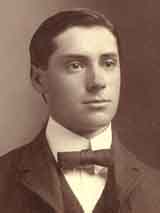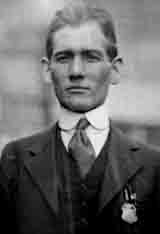
Albert C. Felts

Sid Hatfield
On May 19, 1920, Albert C. Felts, Superintendent of the Baldwin-Felts Detective Agency, stepped off passenger train in Matewan, West Virginia. Accompanied by twelve private detectives , he was there to serve eviction notices to striking miners at the Stone Mountain Coal Company, just beyond the city limits of Matewan. Six hours later, Albert Felts, his brother Legrand Felts and five other private detectives lay dead in the streets of Matewan, along with the mayor of Matewan and two bystanders.
Much has been written about this incident and a movie by John Sayles was released in 1987 called "Matewan", a fictional account of the massacre. In 1990, a trove of records were found and donated to the Eastern Regional Coal Archives located in Bluefield, West Virginia. These records were the personal copies of Thomas L. Felts, a partner in the detective agency and the brother of two of the slain detectives in Matewan. The records included newspaper articles of the massacre and subsequent trial of Sid Hatfield, the Chief of Police of Matewan and 18 others. It also included the actual trial transcripts, the interoffice memos of the detective agency as it went about the business of trying to piece together the incidents of that day as well as documentation of the Mohawk incident which preceeded the shoot-out in Welch, West Virginia in which Sid Hatfield and Ed Chambers were killed.
These records reveal a radically different perspective of the events on that fateful day than has been the accepted and idealized version, much of the mis-information perpetuated from Sayles fictional movie. In the actual chain of events, Sid Hatfield, the Chief of Police of Matewan, orchestrated mass, premeditated murder in collusion with pro-union officials and county law enforcement. On the telephone a half hour before the shootings, Sid Hatfield told Tony Webb, the chief deputy of the Mingo County Sheriff's department, that "they would kill the God damned sons-of-bitches before they left town" and set a trap for the detectives at the Chamber's Hardware Store where snipers awaited in second story windows, armed men hid in and around the store and the surrounding area. Through court testimony, detective agency memos and statements from eye witnesses and survivors, "Murder in Mingo" will bring into the light the actual events surrounding this terrible tragedy.





